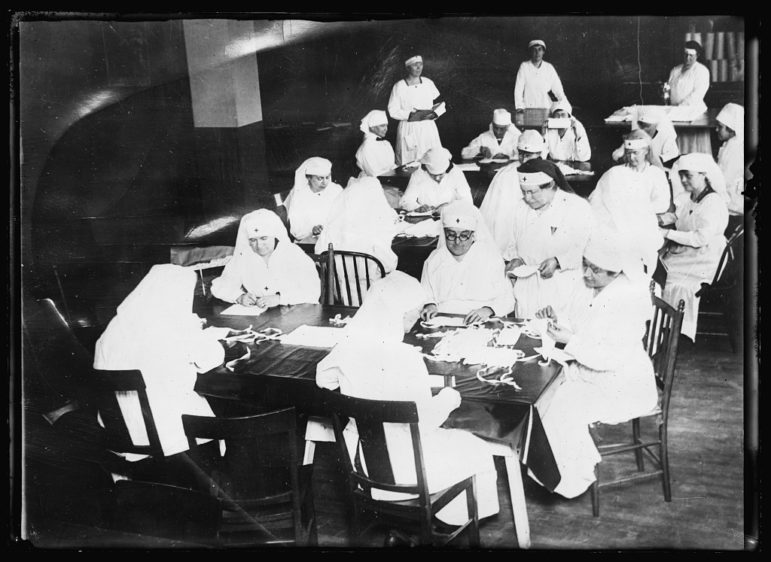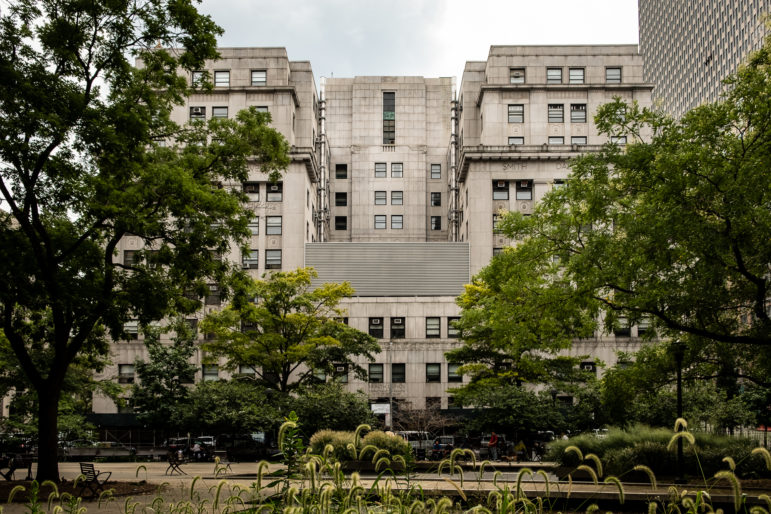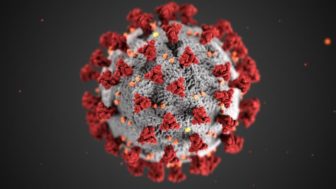Historians say there are many parallels between COVID-19 and past city pandemics, from increased xenophobia to masks campaigns. But the complexities of each outbreak are unique.

Library of Congress/American National Red Cross photo collection
Red Cross workers in New York City turning out medical supplies and hospital equipment to be used by the city health department in its war on influenza in 1920.This story was produced through the City Limits Accountability Reporting Initiative For Youth (CLARIFY), City Limits’ paid training program for aspiring public-interest journalists.
It’s a typical afternoon in New York City. The day’s newspaper headlines include the glaring words, “Hospitals Face Shortages,” while on the subway, commuters are careful to maintain as much distance from one another as the cramped train car allows. A poster features a man with a spout for a nose and a slogan reading “Sneeze But Don’t Scatter,” while other campaigns encourage residents to “Wear a mask and save your life!”
This might seem like an account of life in the wake of COVID-19. Except it’s not 2020—it’s 1918, at the peak of that year’s own influenza pandemic. You’ve just taken a stroll around a version of a New York that ceased to exist a century ago.
It wasn’t all that different from today. New York City has endured a number of outbreaks in its history: influenza, cholera and yellow fever among them. And historians say these past events offer parallels and lessons that can relate to our current crisis, including the danger posed by misinformation and how fear can sow the seeds of bigotry and xenophobia.
“In the past few months, the relevance of history of medicine to the present day and to navigating a path toward the future has become increasingly, visibly relevant,” says Jeremy Greene, director of the Institute of the History of Medicine at Johns Hopkins.
The caveat, Greene adds, is that history never truly repeats itself.
“Responsible historians will never say that we are going through exactly the same thing that happened in 1917, or the polio epidemic in the mid-20th century, or the early days of the AIDS pandemic primarily in the 1980s,” he says. “Each one of these historical examples is simply a useful lens to measure ourselves against, and to better understand some of the social or biological complexities that we’re seeing right now.”
Though there are many parallels between this pandemic and those of the past, historians warn against making direct analogies. Certain variables—such as war, the structure of the healthcare system, and medical advancements—means we’re more echoing history than repeating it. Still, it’s critical to understand the past so that it can inform our current outlook and policies, experts say.
“It’s most important to draw the analysis,” says Greene. “But then it’s crucial to rely on change as well, and say, ‘Well, here are the ways—the vast number of ways—in which there might’ve been differences.”
Different symptoms, misconceptions
In past pandemics, a lack of medical understanding meant the way a disease physically manifested itself typically skewed the city’s response to it, and the public’s perception of it. In the case of the 1918 influenza outbreak in New York and elsewhere, symptoms seemed to surface almost immediately.
“People would be walking down the street, everything perfectly normal, and then suddenly drop dead in the middle of the sidewalk,” said Bronx Borough Historian Lloyd Ultan. “Things like that happened. Nobody knew what caused it, really: what caused the infection and how it was transmitted from one person to another.”
That uncertainty around how diseases spread led to a number of theories that pervaded the mainstream: Some people believed influenza was transmitted solely by spit; others thought it spread when one came in contact with an infected persons’ stool.
An incomplete understanding of the disease could be partially blamed for the speed with which influenza ripped through the population, leaving people unprepared for a second wave of infections even more devastating than the first. Though New York’s outbreak was less fatal than that of cities like Boston and Philadelphia, the city still suffered three waves of the pandemic and saw some 30,000 deaths, according to research from Francesco Aimone, a public expert who has studied the 1918 pandemic and the city’s response to it.
“During the first wave, it was an effect really similar to what we’re seeing now with COVID—a lot of people got sick, and the people who died were either very young or very old,” says Aimone. “In the fall wave, the second wave, that shifted. And that was really scary, because most of the mortalities were people who were in the crowd of 30- to 50-year-olds, and 20- to 40-year-olds.”
Diseases’ timelines posed challenges
While illnesses like flu emerge quickly, other pandemic diseases in New York’s past, such as polio and HIV/AIDS, can lie dormant for months before an infected person begins to exhibit symptoms, making it harder to control.
“Most people who get polio have only mild symptoms, they may never know they had polio, and then they get better. But in a fraction of patients, that’s where the terrible things happen, you know, leading to long term neurological dysfunction and paralysis,” says Greene.
While many past epidemic diseases eventually became less harmful as they mutated, or were successfully eradicated over time, polio continued to persist throughout the 20th century in New York. After a major outbreak in 1916, which originated in Brooklyn but infected over 25,000 people throughout the city, the disease continued to resurface in smaller patches until Jonas Salk produced an effective vaccine in 1955. Much like coronavirus, polio could be very subtle in its symptoms, making it extremely difficult to combat, experts say.
While a lot was still unknown during past outbreaks, the rudimentary understanding that health officials did have inspired some of the basic preventative measures we utilize today, historians say. During the influenza outbreak, many wore cloth masks so as not to inhale what was then referred to as “disease carrying agents.” Others fled to rural areas in an early effort to social distance, similar to the exodus of city residents this spring as coronavirus peaked.
The media, xenophobia and disproportionate impact
Much like today, the media played a large role in informing—or misinforming—the public during past epidemics.
“In 1918, newspapers had, every single day, reports about increases in the number of cases, and charts of the number of deaths in that city or community,” American University history professor Alan Kraut tells City Limits. “They were aware of what was going on, and reporting what was going on.”
Very often, however, journalistic shortcomings could have medical consequences.
One of the misconceptions perpetuated by newspapers and other institutions was that immigrants were to blame for America’s plagues.
“People were doing consistent and furious reporting,” says Sarah Henry, curator for the Museum of the City of New York, which in 2018 hosted an exhibit exploring the history of New York outbreaks entitled, “Germ City: Microbes and the Metropolis.”
“Now were they neutral? Absolutely not,” Henry says of the media coverage at the time. “Were they infallible? Of course not.”
One of the misconceptions perpetuated by newspapers and other institutions was that immigrants were to blame for America’s plagues. Through the three waves of the 1918 Influenza outbreak, for example, the sickness was widely referred to by major publications like the New York Times as “the Spanish Influenza,” or “Spanish grip.” While historians are unsure of the origins of the disease, the first recorded case emerged in Fort Riley, Kansas—not in Spain.
The tradition of blaming certain groups for illnesses dates as far back as bubonic plague in the 13th century. It manifested in New York during the 17th and 18th centuries, when people blamed immigration for outbreaks of fever, calling it “the strangers’ disease.”
“The visual culture of the 19th Century definitely depicted immigrants as infected, dangerous, as disease ridden—almost as vermin,” Henry says. “The print media at that time, especially the media culture … increasingly enforced those perceptions and those divisions in New York society.”
In one later instance, during the polio outbreak of 1916, newspapers contributed to widespread stigma by collaborating with the Department of Health to publish names and addresses of diagnosed patients, the goal being to warn against going into certain neighborhoods.
“In addition to a medical stress test, it’s a social stress test. And wherever there are social flaws with society, they come right up to the surface during a period like this.”
For centuries, humans have displayed “a tendency to otherize populations” in the face of hardship, especially when those hardships are mysterious or unexplainable, says Robert Fullilove, a sociomedical sciences professor at Columbia University.
“What’s more unexplainable than having whole populations die at the hand of something that can’t be seen, can’t be experienced directly with our senses, but that obviously kills?” he says. “Before there was science, there was the belief that this was brought on by someone or something else.”
Outbreaks often amplify already-existing stereotypes and biases, according to experts.
“I guess one way of putting it is that an epidemic is a stress test for society,” Kraut says. “In addition to a medical stress test, it’s a social stress test. And wherever there are social flaws with society, they come right up to the surface during a period like this.”
Death and disparities
As in the COVID-19 outbreak, certain demographic and socioeconomic groups were indeed harder hit in past pandemics than others.
During the cholera outbreaks of the 19th century, for example, the immigrant poor in New York City experienced high rates of the disease due to crowded housing. As the city’s population grew exponentially in the 1800s, unsanitary living conditions were exacerbated by the lack of sewers or a water system. All types of disease swept the city during the Industrial Revolution, and poor immigrant populations were typically the first affected.
As immigration increased, many blamed new diseases on the newcomers’ arrival, perpetuating harmful stereotypes about different immigrant groups, such as Jewish immigrants being associated with trachoma. These assumptions were not backed up by data, experts say.

Adi Talwar
The New York City Department of Health was founded in 1866 after a cholera outbreak. DOH was loacted at 125 Worth Street from December of 1935 to 2011. The above is the former DOH head quarters as seen from the Collect Pond Park in Downtown Manhattan.While immigrants themselves were not the cause of disease, as some believed, it was generally true that poorer communities were first struck by outbreaks. Immigrants living along the coast and working along the docks contracted illnesses which often arrived by boat, Rosner tells City Limits. The wealthy had means to escape the disease-infested city in search of cleaner air, and tended to be the last and least affected.
“In the way they thought about disease, of course the poor died more. They thought of poverty as a social stigma,” says Rosner.
Fear of immigrants during some outbreaks was so strong it manifested in violence. In 1858, Staten Island locals heard reports that patients at the nearby Quarantine Hospital had contracted yellow fever. Fearing the spread, men burned down the institution that for decades had housed sick passengers taken off ships entering New York Harbor.
In New York, the polio epidemic of 1916 that was first discovered in working class neighborhoods held the same social stigma as the cholera epidemic before it, and was often associated with dirt and filth. People blamed immigrants’ lack of hygiene for outbreaks, despite the fact that polio actually impacted native-born middle class neighborhoods at a higher rate than the immigrant poor, according to Gerald Oppenheimer, professor of Clinical Sociomedical Sciences at the Mailman School of Public Health.
Xenophobia around disease has carried into modern times as well. During the AIDS epidemic, Haitians were blamed for bringing the disease to the U.S., and it was sometimes called the “4-H disease,” a nickname derived from the groups then considered most susceptible: homosexuals, intravenous heroin users, hemophiliacs and Haitians. The stigma had consequences: According to a 1983 New York Times article, a New York AIDS task force reported to then-Governor Mario Cuomo an increase in social discrimination towards Haitians and multiple cases of Haitians being unjustly fired from their jobs.
Similarly, President Donald Trump’s labelling of COVID-19 today as the “Chinese Virus” has been criticized by many who say it has fueled a rise in xenophobia against Asian Americans. In New York City, the Commission on Human Rights received hundreds of discrimination complaints related to COVID-19 in March and April, more than 40 percent of them anti-Asian, according to an article in the Wall Street Journal.
“We […] have inherited that baggage of racism, that baggage of anti-Semitism, baggage of anti-urbanism, baggage of this morality of which was so basic to how we understood disease, Rosner says.
The evolution of ‘control’
New York and other cities have commonly used four tactics to combat infectious disease outbreaks in the past: containment, investigation, care, and ‘urban environment,’ or the infrastructure of public health, according to Henry of the Museum of the City of New York. The museum used these four categories to organize its historical pandemic exhibit in 2018.
Containment, she says, is a means of control that has varied greatly over the past century.
“In New York City, that might mean preventing people from coming into the city in the first place, particularly through the port, when we were a major seaport, or later on, the airport,” she says. “But it can also mean containing people and germs physically, whether creating at-home quarantines or quarantine locations.”
Another example was urging residents to don protective face coverings in public. During the 1918 flu epidemic, much like today, the wearing of masks was encouraged to the point that legal action was threatened against those who chose not to.
“The same mechanisms that we’re seeing now that we’re using to control behavior—wear a mask, don’t spit in public, keep social distance—are more or less the same mechanisms that were available then,” says Aimone. “They were, at first, trying to persuade people not to do it, so ‘Please don’t.’ But then as things got more serious, it became ‘You shall not.’ And that’s when the police got involved.”
While there was a similar public pushback against such regulations a century ago, historians say it was less dramatic than what we’re seeing today.
“They didn’t really have this reaction of ‘I’m going to storm the Capitol,’” Aimone says, referring to protestors who stormed the Michigan Capitol in April.
New York’s early attempts to contain the spread of influenza targeted facilities like public transportation, where Ultan says anti-spitting rules from 1918 remain in place today (spitting on the subway in present-day New York could earn you a $100 fine, according to the MTA’s rules of conduct).
Other remnants of past outbreaks remain today: The city’s first Health Department, for instance, emerged in 1866 in response to both a cholera epidemic and as a means of control following a period of race riots in the city, according to Rosner.
“It came about as much in order to do good for the population as it was to control those populations,” he says. “There was also the tendency of terrible repression of people based on disease status.”
Containment efforts also included involuntary quarantine measures. A famous example is that of the immigrant Mary Mallon, or Typhoid Mary, who was forced to isolate on the East River’s North Brother Island after being identified as a spreader of the disease despite never showing any symptoms herself.
Losses and wins
“New York was definitely a place where lots of different breakthroughs occurred, and important new treatments were pioneered.”
Another government response measure in the past, investigation, was limited in its effectiveness by a lack of medical and scientific understanding at the time. To a degree, this problem remains, as governments’ initial responses to COVID-19 were flawed by misunderstandings, according to Fullilove.
A New York Times article from September 1918 describes how then-City Health Commissioner Royal Copeland downplayed the threat of a ship which recently carried 25 flu-infected passengers to New York’s shore. The passengers were isolated and treated, the paper reported, saying “persons in this city are in no danger of an epidemic, according to Dr. Royal S. Copeland.” Just months later, a third wave of influenza occurred, infecting 706 New Yorkers and killing 67.
But there were also successes.
“New York was definitely a place where lots of different breakthroughs occurred, and important new treatments were pioneered,” Henry says.
In 1918, New York City ran an unparalleled nurse service in poorer neighborhoods, according to Rosner. It was also at New York’s Sea View Hospital that Dr. Edward Robitzec discovered a cure for tuberculosis in 1952. Much of the city’s current hospital and public health facility infrastructure was also shaped by past illnesses, Henry says.
Other government response measures included things like health inspections, vaccinations and campaigns for personal hygiene. During some past pandemics, these public-health campaigns promoted a misleading face of the illness: posters used by the March of Dimes, a government foundation raising money for polio research, showed only white children, despite children of all races being affected by the disease, Oppenheimer says. Similarly, the impact of the early AIDS epidemic on women and people of color was often overlooked.
“As long as people of color were invisible, they did not get the same kind of public health and medical interest,” Oppenheimer says.
Like the current crisis, earlier epidemics affected New Yorkers differently across lines of race and class, and had a disproportionate impact on the working poor and those in poverty. The legacy of those structural disparities lingers today, when COVID-19 has been deadliest among Black and Latino residents.
“It’s a system that creates these disparities, and creates these different epidemiologic regions of who gets sick and who doesn’t,” Oppenheimer says. “We are sacrificing people. We have today and have been since the beginning of the 19th century.”








